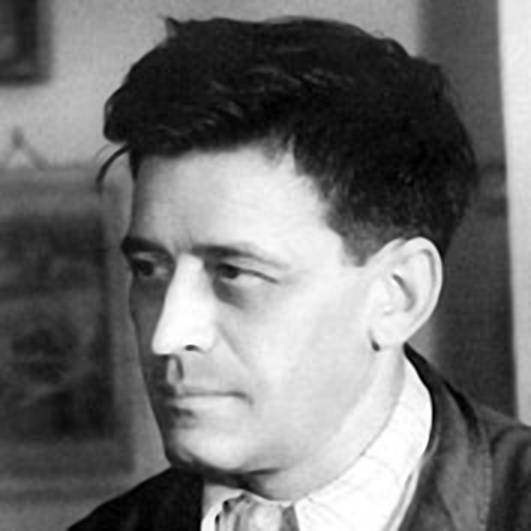Art Investment
Pougny Ivan Albertovich
1894–1956
Pseudonyms,autonyms and aliases: Jean
БИОГРАФИЯ

POUGNY Ivan (Jean) Albertovich
Painter, graphic artist, sculptor, scene-designer
Pougny was born to a family of famous violoncellist. His grandfather, Cesare Pougny (1802–1870) was a famous Italian composer of ballet music, who headed Paris Opera, and later worked in St. Petersburg for the Imperial Theatres. Pougny was educated in his family. In 1910 he went to Italy to treat tuberculosis. Then Pougny moved to Paris, where he entered the Academy of R. Julian. But he also studied in other workshops.
In 1912 Pougny returned to St. Petersburg. Shortly after, he met brothers Burliuk, K. Malevich, V. V. Mayakovsky, V. V. Khlebnikov, M. V. Matyushin and other representatives of the Russian avant-garde. He joined the Union of Youth. In 1913–1914 he visited Paris one more time. In 1913 he married the artist Ksenia Boguslavskaya, who he met in Paris. Pougny exposed his works at the Salon of Independents.
In 1914 Pougny created a sketch of the cover of the futuristic anthology Rykayushchiy Parnas (“Roaring Parnassus”), published on the money of his wife. In 1912–1917 he took part in the exhibitions of the Union of Russian Youth (1912–1913, 1913–1914), the group Bubnovy Valet (“Jack of Diamonds”, 1917); he also was one of the organizers of the exhibitions Tramway V и 0.10. In 1915, on the threshold of the exhibition 0.10, Pougny together with Boguslavskaya, Malevich and I. V. Clyun created a leaflet setting out his artistic credo: “The painting is the new concept of abstract real elements devoid of sense.” In January of 1916 Pougny and Malevich gave a lecture Cubism–Futurism–Suprematism at the Tenishev School.
In 1917 Pougny became one of the founders of the union Freedom to the Art. Since 1918 he was a professor at the State Art Workshops in Petrograd. In 1919 Pougny was invited by Marc Chagall to teach at Vitebsk Art School. He together with Boguslavskaya was engaged in agitational decoration of Petrograd streets for the first October anniversary. Pougny worked at the State Porcelain Factory and performed the project of the seal of the Soviet of the People’s Commissars (Sovnarkom). In 1918–1929 he participated in many Soviet exhibitions, including the exhibition Russian Landscape in Petrograd (1918) and the exhibition of latest trends of art in Leningrad (1927).
In late 1919 Pougny went to Finland, in 1920 he moved to Berlin. He was engaged in book design. Pougny created non-figurative paintings. He joined the November group which united the avant-garde artists of different trends. In 1921 Pougny participated in exhibitions of this group in Berlin and Düsseldorf, and in 1922 he exposed his works in Prague. In 1921 and in 1923 his personal exhibitions were held at the gallery Der Sturm (“Storm”). In 1923 he published book Modern Painting in Berlin, where he subjected the non-figurative art to criticism. Pougny resigned suprematism and gave preference to V. V. Kandinsky.
In 1923 Pougny moved to Paris. He was friends with F. Leger, A. Marquet, and G. Severini. In mid 1920s after being engaged in cubism, constructivism, and dadaism, he started to work in the field of figurative painting in the impressionistic manner, like P. Bonnard and E. Vuillard. In 1924 Pougny exposed his works at the Tuileries Salon. He also took part in the International Exhibition in Brussels (1928) and the exhibition of the Modern French Art in Moscow (1928). Personal exhibitions of the artist were organized in the galleries Barbazanges (1925), Bernheim (1928), Castell (1933), and Le Niveau (1937).
In 1940–1942 Pougny lived in the south of France, in Antibes. In 1942 he returned to Paris. In 1943 Pougny’s personal exhibition was held at the L. Carre gallery. In 1946 he was admitted to French citizenship, and soon after he was conferred the Legion of Honor.
Pougny was a very versatile artist, but he was best known as a painter. Even his reliefs, created in mid 1910s, were rather the development of two-dymensional surface, then spatial constructions. Evolution of his works in many respects was defined by permanent internal conflict between emotional and expressionistic features of his artistic temperament, which prompted him to turn from the synthetic style of early fauvistic canvases to the analytical concept of the non-figurative art, and then to return back to synthetic colorful still lifes in 1917–1919. During Pougny’s life in Berlin, this oscillation decreases. Pougny even found it necessary to reject his suprematic formal achievements. However, the criticism of the artist of his own abstract works does not negate their importance for the development of modern art.
Works by Ivan Pougny are in many museums around the world, including the State Tretyakov Gallery in Moscow, the State Russian Museum in St. Petersburg, the Museum of Modern Art in New York, the Tate Gallery in London and others.
Новости - Hot news
Открыты 478-е торги AI Аукциона
01.05.2023Неизвестный известный Серж Иванов. 1893–1983
06.03.2023Открыты 469-е торги AI Аукциона
27.02.2023Открыты 429-е торги AI Аукциона
12.05.2022The king walks in any weather. Personal exhibition of artist Andrew Munz AI in the gallery "XXI century. Contemporary Russian art"
17.08.2020A common story: Artsy. Part 1
13.08.2020Open 342-е the Auction and 28-й curator's auction "XXI century"
11.08.2020Artist of the week: Leonid Purygin
10.08.2020Cross-trades in the summer of 2020. ArtTactic Report
06.08.2020Услуги ARTinvestment
Арт-консалтинг
Индивидуальные консультации от опытных искусствоведов по любым вопросам в сфере искусства
Составление Инвестиционного Портфеля
Подбор предметов искусства для инвестирования под любую инвестиционную стратегию
Индивидуальная оценка
Наши эксперты проведут профессиональную оценку вашего предмета искусства, учитывая его состояние, авторство, историю и другие факторы
Проведенных аукционов
Зарегистрированных пользователей на аукционе
Записей в базе
Художников в базе

